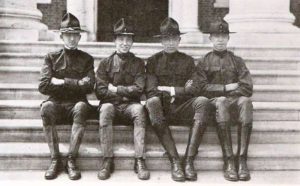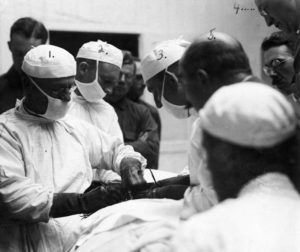
“Junior Class Hullabaloo Board,” Exhibits: The Sheridan Libraries and Museums, Johns Hopkins University
Chemistry professors recruited to do research in chemical warfare. Surgeons developing revolutionary new techniques to deal with gruesome war injuries. Nurses stepping into unprecedented new leadership roles at home and on the warfront. Student soldiers living in engineering classrooms converted to barracks. All these things and more were experienced by the Johns Hopkins community during World War I.
This fall, Johns Hopkins University launched Hopkins and the Great War, its first multi-campus collaborative exhibit. The exhibit opened in September 2016 in three locations: The Milton S. Eisenhower Library on the Homewood campus, the School of Nursing Anne M. Pinkard Building, and the William H. Welch Medical Library. Drawing on the rich archival collections at the Alan Mason Chesney Medical Archives and the Ferdinand Hamburger University Archives, these exhibits explore World War I’s impact on different members of the Hopkins community: the students, faculty, and female patrons of the undergraduate Homewood campus, and the doctors, nurses, students, and faculty of the Johns Hopkins Hospital and the schools of Nursing, Medicine and Public Health.
Our exhibit curators included archivists at both the Medical and University Archives as well as a historian of medicine. In addition to the physical exhibits, a digital exhibit is available with enhanced content, including links to the full text of publications and diaries featured in the exhibit.
Each physical exhibit location hosted an exhibit opening. On September 14 at the Eisenhower Library, Dr. Alice Kelly, Harmsworth Junior Research Fellow in the History of America and the First World War at Oxford University’s Rothermere American Institute and Corpus Christi College, presented “Ellen N. La Motte: A Hopkins Nurse in the Backwash of War.” Kelly’s talk explored La Motte’s startlingly graphic 1916 memoir and newly discovered correspondence now part of the Chesney Medical Archives’ La Motte Collection in the broader context of World War I literature and the wartime avant-garde.

“Photograph of a Surgery in the General Operating Room,” Exhibits: The Sheridan Libraries and Museums, Johns Hopkins University
On October 18, historian Marian Moser Jones, University of Maryland-College Park, presented “Dispatches from the Second Battlefield: Four Hopkins Nurses Tell Their World War I Stories.” Jones examined the wartime experiences of Hopkins nurses Vashti Bartlett, Ellen La Motte, Alice Fitzgeraldand Bessie Baker within the context of a larger scholarship about World War I nurses as sister soldiers.As part of the School of Nursing’s annual reunion on September 23, storyteller Ellouise Schoettler performed her one woman show, “Ready to Serve: A Story of Hopkins Nurse in World War I.” In this moving first person account, Schoettler brought to life the reminiscences of a World War I nurse who served with the Johns Hopkins Base Hospital Unit 18 in France.
That all 3 exhibit openings featured the stories of nurses speaks to the significance of women’s involvement in the war, service for which they claimed the right to suffrage as “Justice for Women as a War Measure”. Telling stories of women engaged in the health professions in the midst of war bridges medicine and the humanities, as do the stories of the male doctors and soldiers featured in the exhibit.
Hopkins and the Great War will be on display in the three physical locations through January 2017. The Hopkins libraries and archives welcome History Day students and World War I scholars to explore the exhibit and our wealth of World War I collections throughout the centennial period. The exhibit features just a small portion of the extensive resources that can be used to explore the themes of the exhibit in greater detail.
About the authors:
Phoebe Evans Letocha is Collections Management Archivist at the Alan Mason Chesney Medical Archives of the Johns Hopkins Medical Institutions. She served as curator for the Nursing section of the Hopkins and the Great War exhibit.
Jenny Kinniff is Hopkins Retrospective Program Manager at The Sheridan Libraries. She served as curator for the Homewood section of the Hopkins and the Great War exhibit.
This piece was originally posted on the Maryland Humanities blog on October 26, 2016.





